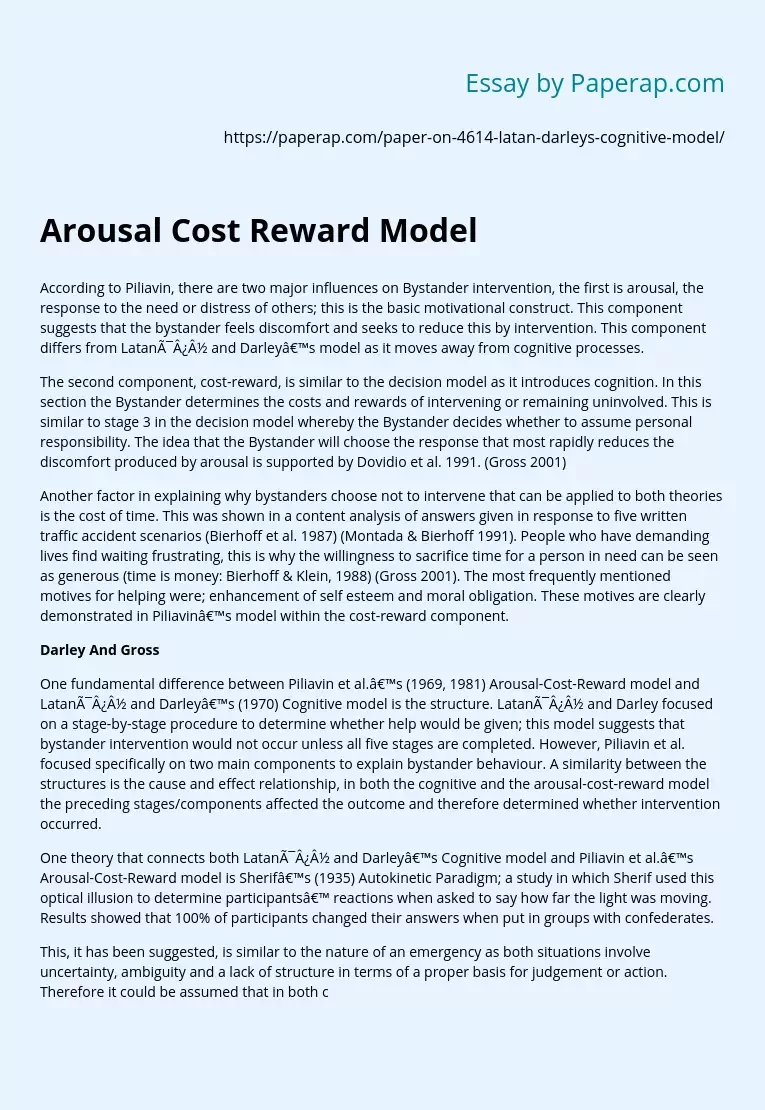Arousal Cost Reward Model
According to Piliavin, there are two major influences on Bystander intervention, the first is arousal, the response to the need or distress of others; this is the basic motivational construct. This component suggests that the bystander feels discomfort and seeks to reduce this by intervention. This component differs from Latan� and Darley’s model as it moves away from cognitive processes.
The second component, cost-reward, is similar to the decision model as it introduces cognition. In this section the Bystander determines the costs and rewards of intervening or remaining uninvolved.
This is similar to stage 3 in the decision model whereby the Bystander decides whether to assume personal responsibility. The idea that the Bystander will choose the response that most rapidly reduces the discomfort produced by arousal is supported by Dovidio et al. 1991. (Gross 2001)
Another factor in explaining why bystanders choose not to intervene that can be applied to both theories is the cost of time. This was shown in a content analysis of answers given in response to five written traffic accident scenarios (Bierhoff et al.
1987) (Montada & Bierhoff 1991). People who have demanding lives find waiting frustrating, this is why the willingness to sacrifice time for a person in need can be seen as generous (time is money: Bierhoff & Klein, 1988) (Gross 2001). The most frequently mentioned motives for helping were; enhancement of self esteem and moral obligation. These motives are clearly demonstrated in Piliavin’s model within the cost-reward component.
Darley And Gross
One fundamental difference between Piliavin et al.’s (1969, 1981) Arousal-Cost-Reward model and Latan� and Darley’s (1970) Cognitive model is the structure.
Latan� and Darley focused on a stage-by-stage procedure to determine whether help would be given; this model suggests that bystander intervention would not occur unless all five stages are completed. However, Piliavin et al. focused specifically on two main components to explain bystander behaviour. A similarity between the structures is the cause and effect relationship, in both the cognitive and the arousal-cost-reward model the preceding stages/components affected the outcome and therefore determined whether intervention occurred.
One theory that connects both Latan� and Darley’s Cognitive model and Piliavin et al.’s Arousal-Cost-Reward model is Sherif’s (1935) Autokinetic Paradigm; a study in which Sherif used this optical illusion to determine participants’ reactions when asked to say how far the light was moving. Results showed that 100% of participants changed their answers when put in groups with confederates.
This, it has been suggested, is similar to the nature of an emergency as both situations involve uncertainty, ambiguity and a lack of structure in terms of a proper basis for judgement or action. Therefore it could be assumed that in both cases the individual will look to others for guidance on how to think and act. This has been shown in Latan and Rodin’s (1969) experiment (Latan & Nida 1981) and also in the case study of Kitty Genovese case (1964) (Gross 2001).
Research has found that not only does the influence of others determine Bystander Behaviour; gender is also seen to have an effect on Bystander intervention. In terms of the arousal-cost component of Piliavin’s model, research has suggested that women help only certain people in certain ways (Eagly & Crowley 1986). This could help to explain why some bystanders experience higher levels of arousal than others. The idea of gender could also be applied to Latan and Darley’s cognitive model within the final stage in that women may feel more competent in some situations and therefore are more likely to intervene then men.
In conclusion, Latan� and Darley’s (1970) Cognitive model and Piliavin et al.’s Arousal-Cost-Reward model have many similarities between them. They both attempt to explain why bystanders intervene in an emergency by using cognitive processes; they also address the possibility of social influences affecting bystander intervention. However a fundamental difference between them is in the cost-reward component of Piliavin’s model as it raises the issue of personal gains or costs from intervening whereas Latan� and Darley only address this briefly within stage three of the decision model. Despite these similar and contrasting ideas both theories have had a huge impact on social psychology and continue to generate research.
References:
Cardwell, M., Clark, L., Meldrum C. (2001). Psychology for A2 Level. p64.
Corsini, R.J. (1999) The Dictionary of Psychology. p133.
Eagly, A and Crowley, M. (1986). Gender and Helping Behaviour: A meta analysis review of the social psychology literature. Psychological Bulletin, vol 100, no 3, p284.
Gross, R. (2001). Psychology: The Science of Mind and Behaviour (Fourth Edition). pp434-438.
Arousal Cost Reward Model. (2019, Dec 05). Retrieved from https://paperap.com/paper-on-4614-latan-darleys-cognitive-model/

